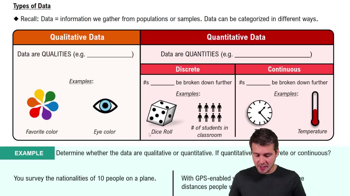In a certain hypothesis test, , < . You collect a sample and calculate a test statistic . Find the -value.
Table of contents
- 1. Intro to Stats and Collecting Data1h 14m
- 2. Describing Data with Tables and Graphs1h 55m
- 3. Describing Data Numerically2h 5m
- 4. Probability2h 16m
- 5. Binomial Distribution & Discrete Random Variables3h 6m
- 6. Normal Distribution and Continuous Random Variables2h 11m
- 7. Sampling Distributions & Confidence Intervals: Mean3h 23m
- Sampling Distribution of the Sample Mean and Central Limit Theorem19m
- Distribution of Sample Mean - Excel23m
- Introduction to Confidence Intervals15m
- Confidence Intervals for Population Mean1h 18m
- Determining the Minimum Sample Size Required12m
- Finding Probabilities and T Critical Values - Excel28m
- Confidence Intervals for Population Means - Excel25m
- 8. Sampling Distributions & Confidence Intervals: Proportion1h 12m
- 9. Hypothesis Testing for One Sample3h 29m
- 10. Hypothesis Testing for Two Samples4h 50m
- Two Proportions1h 13m
- Two Proportions Hypothesis Test - Excel28m
- Two Means - Unknown, Unequal Variance1h 3m
- Two Means - Unknown Variances Hypothesis Test - Excel12m
- Two Means - Unknown, Equal Variance15m
- Two Means - Unknown, Equal Variances Hypothesis Test - Excel9m
- Two Means - Known Variance12m
- Two Means - Sigma Known Hypothesis Test - Excel21m
- Two Means - Matched Pairs (Dependent Samples)42m
- Matched Pairs Hypothesis Test - Excel12m
- 11. Correlation1h 6m
- 12. Regression1h 50m
- 13. Chi-Square Tests & Goodness of Fit1h 57m
- 14. ANOVA1h 57m
9. Hypothesis Testing for One Sample
Steps in Hypothesis Testing
Problem 8.1.25
Textbook Question
Type I and Type II Errors
In Exercises 25–28, provide statements that identify the type I error and the type II error that correspond to the given claim. (Although conclusions are usually expressed in verbal form, the answers here can be expressed with statements that include symbolic expressions such as p = 0.1.)
The proportion of people who write with their left hand is equal to 0.1.
 Verified step by step guidance
Verified step by step guidance1
Understand the context: The problem involves hypothesis testing, where we are given a claim about the proportion of people who write with their left hand (p = 0.1). We need to identify the Type I and Type II errors associated with this claim.
Define the null and alternative hypotheses: The null hypothesis (H₀) is that the proportion of people who write with their left hand is equal to 0.1 (H₀: p = 0.1). The alternative hypothesis (H₁) is that the proportion of people who write with their left hand is not equal to 0.1 (H₁: p ≠ 0.1).
Recall the definition of a Type I error: A Type I error occurs when the null hypothesis (H₀) is true, but we incorrectly reject it. In this case, a Type I error would mean concluding that the proportion of left-handed people is not 0.1 when, in fact, it is 0.1.
Recall the definition of a Type II error: A Type II error occurs when the null hypothesis (H₀) is false, but we fail to reject it. In this case, a Type II error would mean failing to conclude that the proportion of left-handed people is not 0.1 when, in fact, it is different from 0.1.
Summarize the errors: A Type I error corresponds to rejecting H₀ (p = 0.1) when it is true, and a Type II error corresponds to failing to reject H₀ (p = 0.1) when it is false.
 Verified video answer for a similar problem:
Verified video answer for a similar problem:This video solution was recommended by our tutors as helpful for the problem above
Video duration:
2mPlay a video:
Was this helpful?
Key Concepts
Here are the essential concepts you must grasp in order to answer the question correctly.
Type I Error
A Type I error occurs when a true null hypothesis is incorrectly rejected. In the context of the given claim, it would mean concluding that the proportion of left-handed people is not equal to 0.1 when, in fact, it is. This error is often referred to as a 'false positive' and is denoted by the significance level alpha (α), which represents the probability of making this error.
Recommended video:
Guided course

Types of Data
Type II Error
A Type II error happens when a false null hypothesis is not rejected. In relation to the claim about left-handedness, this would mean failing to conclude that the proportion of left-handed people is different from 0.1 when it actually is. This error is known as a 'false negative' and is represented by beta (β), which indicates the probability of making this error.
Recommended video:
Guided course

Types of Data
Null Hypothesis
The null hypothesis is a statement that there is no effect or no difference, serving as a default position in hypothesis testing. In this scenario, the null hypothesis posits that the proportion of left-handed individuals is equal to 0.1. Understanding the null hypothesis is crucial for identifying Type I and Type II errors, as these errors are defined in relation to whether this hypothesis is correctly accepted or rejected.
Recommended video:
Guided course

Step 1: Write Hypotheses

 6:21m
6:21mWatch next
Master Step 1: Write Hypotheses with a bite sized video explanation from Patrick
Start learningRelated Videos
Related Practice
Multiple Choice
